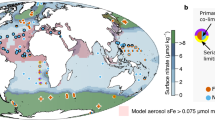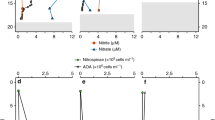Abstract
IRON availability limits phytoplankton growth in large areas of the world's oceans1–3 and may influence the strength of the biological carbon pump4,5. Very little is known of the iron requirements of oceanic heterotrophic bacteria, which constitute up to 50% of the total particulate organic carbon in open ocean waters6,7 and are important in carbon cycling as remineralizers of dissolved organic matter and hence producers of CO2 (ref. 8). Here we report that oceanic bacteria contain more iron per biomass than phytoplankton. In the subarctic Pacific, they constitute a large fraction of biogenic iron and account for 20–45% of biological iron uptake. Bacterial iron quotas in the field are similar to those of iron-deficient laboratory cultures, which exhibit reduced elec-tron transport, slow growth, and low carbon growth efficiency. Heterotrophic bacteria therefore play a major role in the biogeo-chemical cycling of iron. In situ iron limitation of heterotrophic metabolism may have profound effects on carbon flux in the ocean.
This is a preview of subscription content, access via your institution
Access options
Subscribe to this journal
Receive 51 print issues and online access
$199.00 per year
only $3.90 per issue
Buy this article
- Purchase on Springer Link
- Instant access to full article PDF
Prices may be subject to local taxes which are calculated during checkout
Similar content being viewed by others
References
Martin, J. H. et al. Nature 371, 123–129 (1994).
de Baar, H. J. W. et al. Nature 373, 412–415 (1995).
Martin, J. H. & Fitzwater, S. E. Nature 331, 341–343 (1988).
Price, N. M., Ahner, B. A. & Morel, F. M. M. Limnol. Oceanogr. 39, 520–539 (1994).
Coale, K. H., Fitzwater, S. E., Gordon, R. M., Johnson, K. S. & Barber, R. T. Nature 379, 621–624 (1996).
Fuhrman, J. A., Sleeter, T. D., Carlson, C. A. & Proctor, L. M. Mar. Ecol. Progr. Ser. 57, 207–217 (1989).
Kirchman, D. L., Keil, R. G., Simon, M. & Welschmeyer, N. A. Deep-Sea Res. 40, 967–988 (1993).
Williams, P. J. le B. Kiel. Meeresforsch. 5, 1–28 (1981).
Price, N. M. et al. Biol. Oceanogr. 6, 443–461 (1988).
Maldonado, M. T. & Price N. M. Mar. Ecol. Prog. Ser. (in the press).
Brand, L. E. Limnol. Oceanogr. 36, 1755–1771 (1991).
Martin, J. H., Fitzwater, S. E. & Broenkow, W. W. Deep-Sea Res. 36, 649–680 (1989).
Martin, J. H. & Knauer, G. A. Geochim. Cosmochim. Acta 37, 1639–1653 (1973).
Booth, B. C., Lewin, J. & Lorenzen, C. J. Mar. Biol. 98, 287–298 (1988).
Miller, C. B. et al. Limnol. Oceanogr. 36, 1600–1615 (1991).
LaRoche, J., Boyd, P. W., McKay, R. M. L. & Geider, R. J. Nature 382, 802–805 (1996).
Reid, R. T., Live, D. H., Faulkner, D. J. & Butler, A. Nature 366, 455–548 (1993).
Rue, E. L. & Bruland, K. W. Mar. Chem. 50, 117–138 (1995).
Brand, L. E., Sunda, W. G. & Guillard, R. R. L. Limnol. Oceanogr. 28, 1182–1198 (1983).
Sunda, W. G., Swift, D. G. & Huntsman, S. A. Nature 351, 55–57 (1991).
Ingram, J. L., Maaløe, O. & Neidhardt, F. C., Growth of the Bacterial Cell (Sinauer, Sunderland, MA, 1983).
Rainnie, D. J. & Bragg, P. D. J. Gen. Microbiol. 77, 339–349 (1973).
Kirchman, D. L. Mar. Ecol. Prog. Ser. 62, 47–54 (1990).
Hudson, R. J. & Morel, F. M. M. Limnol. Oceanogr. 34, 1113–1120 (1989).
Lee, S. & Fuhrman, J. A. Appl. Envir. Microbiol. 53, 1298–1303 (1987).
Booth, B. C., Lewin, J. & Postel, J. R. Prog. Oceanogr. 32, 57–99 (1993).
Neuer, S. Mar. Ecol. Prog. Ser. 83, 251–262 (1992).
Welschmeyer, N., Goericke, R., Strom, S. & Peterson, W. Limnol. Oceanogr. 36, 1631–1649 (1991).
Packard, T. T. & Williams, P. J. le B. Oceanol. Acta 4, 351–358 (1981).
Author information
Authors and Affiliations
Rights and permissions
About this article
Cite this article
Tortell, P., Maldonado, M. & Price, N. The role of heterotrophic bacteria in iron-limited ocean ecosystems. Nature 383, 330–332 (1996). https://doi.org/10.1038/383330a0
Received:
Accepted:
Issue Date:
DOI: https://doi.org/10.1038/383330a0
This article is cited by
-
First report on biological iron uptake in the Antarctic sea-ice environment
Polar Biology (2023)
-
Petrobactin, a siderophore produced by Alteromonas, mediates community iron acquisition in the global ocean
The ISME Journal (2022)
-
Everything Is Everywhere: Physiological Responses of the Mediterranean Sea and Eastern Pacific Ocean Epiphyte Cobetia Sp. to Varying Nutrient Concentration
Microbial Ecology (2022)
-
Phage-specific metabolic reprogramming of virocells
The ISME Journal (2020)
-
The integral role of iron in ocean biogeochemistry
Nature (2017)
Comments
By submitting a comment you agree to abide by our Terms and Community Guidelines. If you find something abusive or that does not comply with our terms or guidelines please flag it as inappropriate.



